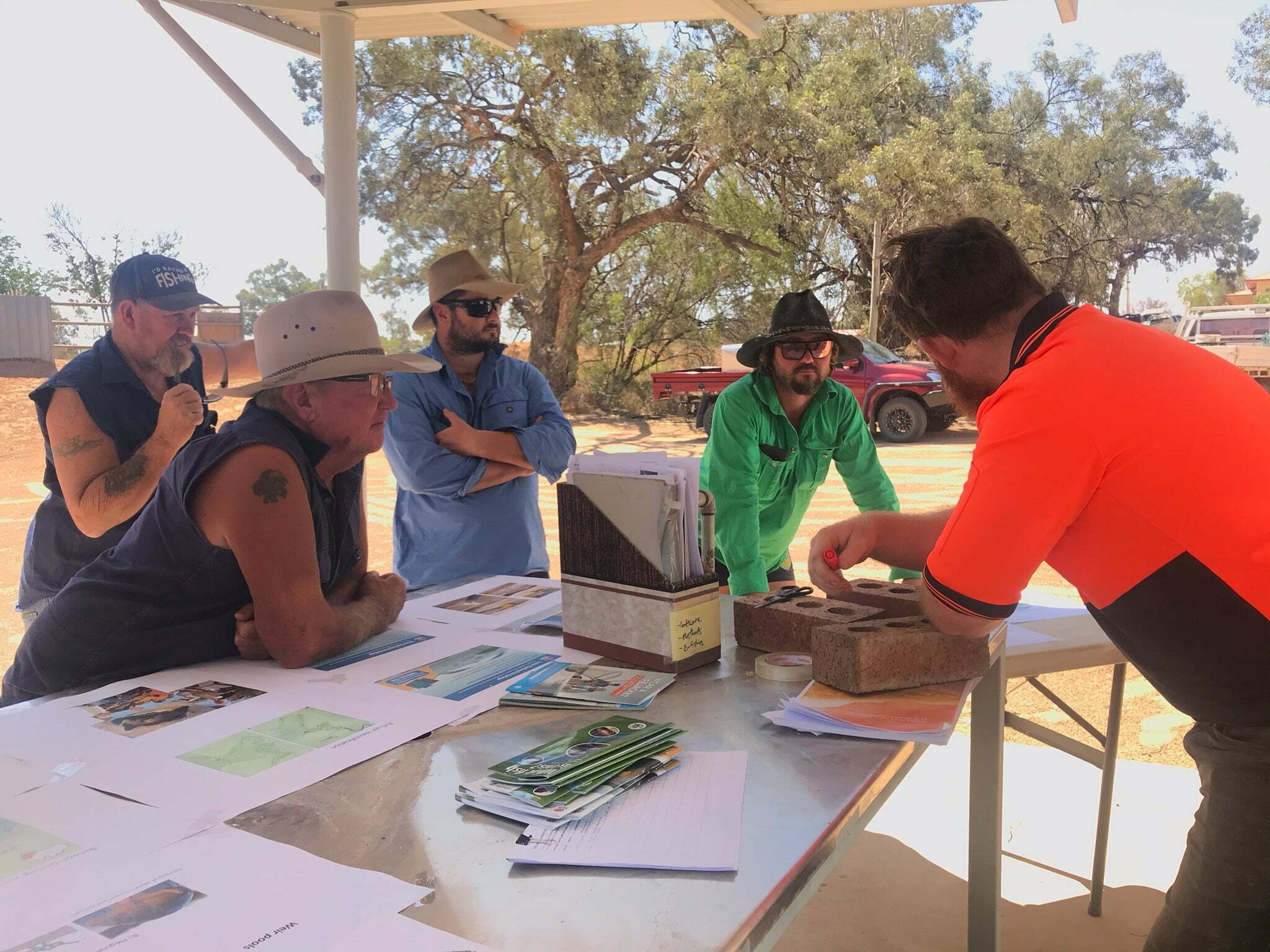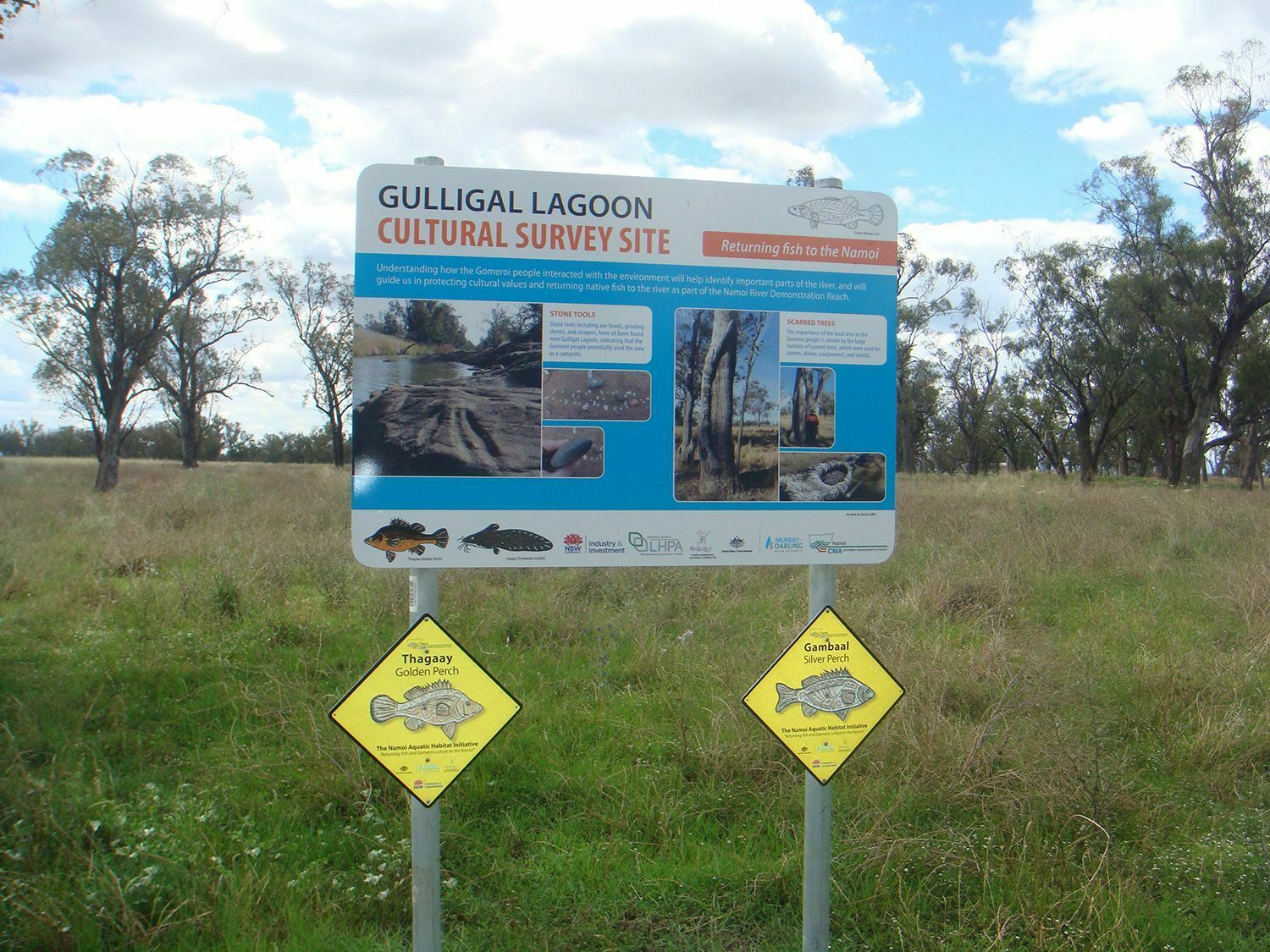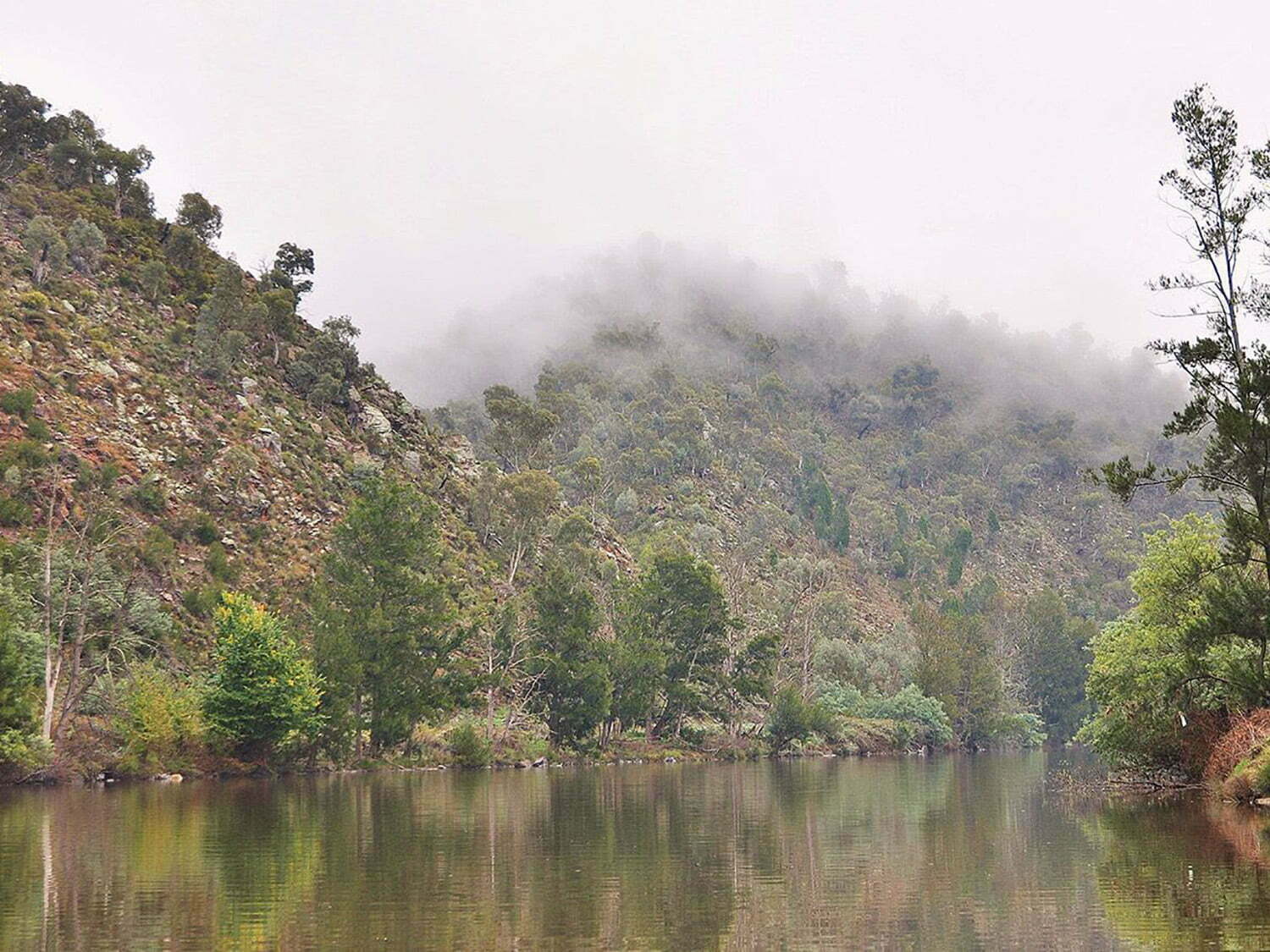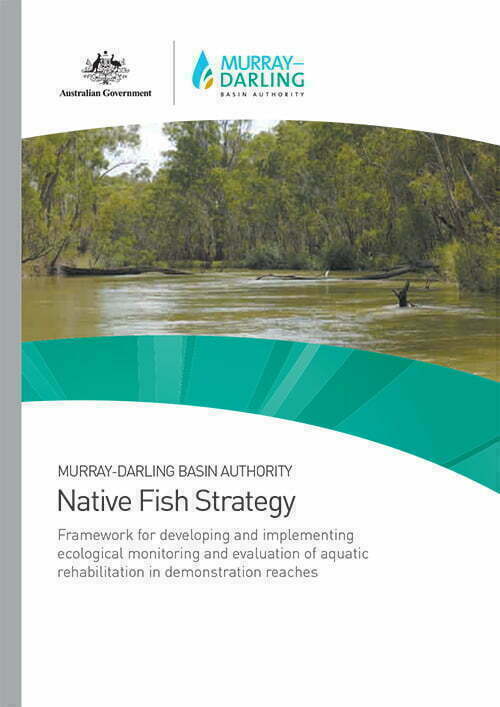Demonstration Reaches

Demonstration Reaches are large scale river reaches or wetlands where members of the community work with government and others to do a range of things to help native fish (for example restoring habitat, improving water quality and restoring migratory pathways). In this way, demonstration reaches show what we can do to restore our native fish communities and the health of our waterways when we really set out minds to it. They represent a coordinated approach to native fish rehabilitation on a broad scale, with an emphasis on strong direct community involvement.
The Demonstration Reach approach recognises the importance of engaging and empowering the community to create strong ownership and stewardship through the development of partnerships. For the Native Fish Strategy high profile reaches were selected – degraded but fixable – and where several threats could be addressed. It was also important for change to be monitored over time by the stakeholders and community members involved. Demonstration sites were located close to large towns so that they were easily accessible, substantial and visible to the public. The attitude of the community living near the demonstration reach was also taken into consideration, since positive attitudes to natural values improved the likelihood of promoting strong and ongoing community support.
The experience of running a Demonstration Reach has been brought together in Finbox which is a ‘toolbox’ that provides guidance and recommendations for how to establish a successful Demonstration Reach. A brief summary about Demonstration Reaches is provided below, but to learn more please go to Finbox and explore the resources that have been brought together to assist anyone interested in using the Demonstration Reach approach.


Demonstration Reaches tackle a complexity of management issues, so the notion of ‘community’ was complex, involving a diverse mix of agencies and people. For example, members of the ‘community’ included: Federal and State Government organisations with a direct role or interest in the project, Local Government, Indigenous communities, fishing clubs, Landcare groups, schools, service clubs, landholders and individuals. The key to managing these different groups was to identify and invite participation from stakeholders who represented the community early on in the project. This enables relationships to be developed and maintained over the long term, with people given responsibility for particular aspects of the project. In this way those involved were empowered to act. Getting people together to develop a shared vision was very important, with meetings and workshops used to identify the many values, threats and issues facing the river reach, as well as the actions the group wished to undertake to address these concerns.
Seven Demonstration Reaches were supported through the Native Fish Strategy. Each was different in terms of size, scale, river issues and community engagement approach. The smallest Demonstration Reach was Hollands Creek (20km), while Brewarrina to Bourke was the largest (207km). Case studies of Hollands Creek and the large and very successful Dewfish Demonstration Reach show how different experiences can be.
- Hollands Creek
- Namoi
- Ovens
- Upper Murrumbidgee
- Dewfish (Condamine River)
- Katfish (Katarapko River)
Brewarrina to Bourke
Community involvement in Demonstration Reaches is vital during selection, establishment and implementation. Including people in site selection, decision making, management actions, monitoring, promotion and communication, builds ownership and long term support for the reach. Each of the Demonstration Reaches tailored their community engagement approaches to ensure they were the ‘perfect fit’ for their local groups. For some of the larger complex reaches, community advisory groups, steering committees and expert panels were used. Other smaller reaches involved a community reference group and a project team.
A communication plan was produced for each Demonstration Reach. These plans summarised the objectives, target audiences, key messages and specific actions to be undertaken. The plans guided activities and were reviewed and updated on a regular basis. Engagement approaches aimed to raise the profile of the Demonstration Reach by sharing the activities being undertaken and highlighting the issues being addressed. Different consultative methods were used from interviews and focus groups, through to surveys. Other engagement activities included:
- producing and sharing resource materials.
- developing targeted awareness raising campaigns.
- undertaking formal education and training.
- including hands on community involvement in monitoring, surveys, on-ground works and activities.
- providing updates on works and monitoring results.
- holding community events and celebrations.
Examples of ‘hands on’ activities that many community members could participate in included:
- recreational fishing and creel surveys
- field days
- training days for plant propagation and weed control
- water quality and environmental flow release monitoring
- oral histories
- Carp musters
- undertaking onground works such as revegetation, weed control, improving fish passage
- fish stockings
- emergency response (e.g. assisting in collection of fish from isolated pools of water, and collection and treatment of turtles in the Coorong)
Examples of raising awareness activities of the Demonstration Reaches included:
- establishing websites
- media releases, TV interviews, newspaper articles
- fact sheets, posters, stickers, hats, calendars
- interpretive signage
- field days and presentations – these can include river walks, showcasing works, sharing knowledge, expert speakers, demonstrating techniques such as electrofishing, fishway openings
- Carp musters
- catch and release fishing competitions
- workshops to highlight specific issues
- cultural workshops such as canoe making and basket weaving
- celebrations such as BBQs and picnics following competition of particular onground works and to promote findings of monitoring
- fishers for fish habitat forums
- school forums, camps, games and curriculum information
- stalls at other associated local events
Demonstration Reach experiences provided valuable insights into the factors needed for successful community engagement. These include:
- strong community ownership, participation and empopwerment is essential in all aspects from the development of strategies and plans, implementation of works and monitoring the outcomes.
- adequate resourcing and commitment to community engagement for the implementation of Demonstration Reaches.
- early identification and recognition of the values and issues for each site.
- establishing a clear shared vision and articulate it to partners and the community so that everyone is working together in the same direction.
- clearly acknowledging differences and limitations and focus on commonalities.
- developing clear communication and engagement strategies and action plans, use them and review them.
- using appropriate approaches for different communities.
- identifying the correct people to contact with respect to stakeholder groups and especially Indigenous communities.
- employing key people who drive the establishment and implementation (the doers) of Demonstration Reaches, including NFS team members high level engagement skills.
- transferring knowledge between all involved (e.g. reach managers, community reference group, NFS coordinators) so that all the elements of the program link closely (e.g. onground works, community engagement, research). This is not to be underestimated !
- managing expectations, including timing of activities, funding and results of rehabilitation – don’t ‘over promise and under deliver’. This builds credibility. If delays occur, be honest and upfront.
- avoid planning without any action, as this can cause breakdowns in partnerships.
- use an adaptive approach, recognising that community values can change and onground situations can change e.g. drought and floods can influence success
- being open, honest, genuine, reliable and inclusive in interactions, and focus on two way dialogue.
- understanding the variety of community issues and concerns, and how these fit into and influence management options.
- using champions and high profile people can be valuable, increasing profile and interest.
- learning from the past, particularly in identifying and acknowledging errors in past management practices.
- learning from science, monitoring and adaptive management to identify how actions may need to change within the reach.
- sharing, celebrating and promoting successes within the Demonstration Reach area and more broadly.
A variety of challenges were experienced during the establishment and implementation of Demonstration Reaches and these are outlined below so that anyone wishing to use the approach can be well informed about some of the difficulties different projects encountered.
- Effective engagement needs to be persistent and ongoing, and is very time consuming. If often grows exponentially – slowly at the start as trust and relationships are build. This is where the role of NFS coordinators was particularly important.
- Effective engagement can be difficult to measure, which can lead to questions of its value by some managers.
- There needs to be significant ‘lead in’ time to build community understanding and support – from determining a vision and objectives, identifying and engaging with all stakeholders.
- Negotiations between stakeholders and the community can be lengthy, detailed and require significant effort, and sometimes required external expertise.
- All stakeholders will have their own personal motivations, which can be complex and difficult to understand.
- Differences in interests of stakeholder groups, and perceptions that particular rehabilitation actions may have negative impacts on them, can lead to conflict and opposition.
- Perceptions of, or real ‘take over’ of events or entire projects by interest groups with a single agenda, can potentially conflict with the project’s aims. This can range from simply dominating discussion at an information session or meeting, to real conflict in a community reference group due to a perceived specific-interest group ‘takeover’. It is important to maintain focus, and regularly reflect on the agreed shared vision.
- The need to use different approaches to engagement to effectively link with different groups can require significant resources and skills.
- Lack of understanding of some stakeholders can hamper agreement on, or support for, activities. This can include:
- local landholders not understanding the environmental benefits of proposed activities (e.g. willow removal, riparian fencing and resnagging), the current status of a waterway or the level of intervention required.
- some believing that simply adding more fish by stocking will achieve a net increase in fish abundance and diversity.
- Some within the community could have existing broader frustration about management of a river, or particular organisations, which may result in an unwillingness to participate in project activities. This sometimes occurred in the early stages, until people began to see on-ground works being implemented, and were encouraged by the participation of others within the community.
- Building community understanding and interest in rehabilitation works and their likely benefits often needed time and significant effort through a variety of means including workshops, community events, one-on-one interactions and local media. Gradual word of mouth from trusted neighbours, and seeing what is happening, established the credentials of the project.
- Unforseen problems such as drought or flood can affect the success of on-ground actions, with the community losing enthusiasm and becoming disillusioned with lack of progress.
- Managing expectations can be difficult. This can include:
- needing long time frames to demonstrate a positive improvement in river health
- our ecological knowledge is imperfect and this needs to be communicated honestly and openly.
- highlighting that while monitoring and demonstrating ecological benefits is one aspect of Demonstration Reaches, others such as building relationships are very important too.
- activities need to be realistic and achievable from the outset.
- Sometimes there were perceptions that Demonstration Reaches were viewed as agency-driven rather than community-driven.
- There is risk of burn out for some participants which needs to be anticipated and managed effectively.
- Robust planning underpinned by good science is vital, as participants can change, potentially leading to loss of momentum and support.
- Vandalism of signage, habitat and tracks, as well as theft, can be an ongoing issue for some sites. Responses to this have required consideration of the practical aspects (e.g. more robust signs; or less robust, cheaper, readily-replaceable signs) as well as the human aspect (e.g. analysing the causes of the vandalism and actively engaging with that sector of the community to build advocacy and ownership for the site). In the Dewfish example, this provided an opportunity to trial new approaches that encouraged site ownership by the local youth and a school-driven community engagement.
NFS annual reports provided detailed discussion of the progress of establishing and implementing Demonstration Reaches, including papers by NFS coordinators, CST members and members of the Demonstration Reach Steering Committee.
Annual reporting for each Demonstration Reach was required to keep track of progress. This provided a useful method of summarising activities..
The importance of monitoring and evaluating community engagement within Demonstration Reaches was recognised, both through the independent review of Demonstration Reaches in 2012 and the Demonstration Reach workshops. If the program had continued, there were intentions to develop a scientifically robust approach to measuring and monitoring community engagement. It was recommended that communication plans incorporate a monitoring and evaluation component for community engagement, rather than developing a separate document. There was also acknowledgement that seeking specialist community communication and engagement knowledge would be valuable in identifying appropriate baseline data and methods. The inclusion of a social researcher on the Demonstration Reach Steering Committee was another idea.
A key aim of Demonstration Reaches was that they would eventually be ‘handed over’ to the community to manage. This meant that a measure of their success would include an assessment of the willingness of agencies and communities to move from ‘Informing’ to ‘Empowerment’.
Success could also be reflected through:
- Increased awareness and participation within projects.
- Commitment to long term management of the investment.
- Changes in community attitudes to the environmental values and how threats should be managed.
The experiences to date with Demonstration Reaches indicated that moving to ‘empowerment’ could be quite gradual. While strong involvement and participation with some parts of the community was achieved reasonably easily, effective engagement with others was more complex and gradual. There was recognition during the 2009 NFS Forum that engagement and participation of angling groups and the Indigenous community could improve.
In addition to the rehabilitation benefits, Demonstration Reaches also modelled the outcomes of effective engagement. NRM managers and community groups in several sites recognised the successful principles, techniques and tools, and applied them to other projects and river reaches. Examples include:
- A local community group from Nundle in north-west NSW, applied learnings from the Namoi Demonstration Reach to engage the local community to establish a rehabilitation reach on the upper Peel River. The project undertook woody weed management and native revegetation, and used field days, workshops and information sessions to engage and empower the local community, who worked together to improve access and use of the river.
- A local champion involved in the Ovens River Demonstration Reach, Victoria, took the same approach to other creeks in the district, establishing a vibrant Restoring Our Waterways group, auspiced under the urban Landcare group.
- Four Victorian communities supporting nationally threatened Macquarie Perch in their local creeks applied rehabilitation lessons from the Hollands Creek Demonstration Reach, linking together to share stories and learn from each other.
- Condamine Alliance has developed the Nikki Long Cod Demonstration Reach for the headwaters of the Condamine River around Killarney to recover the Northern River Blackfish using the framework and learnings from the Dewfish Demonstration Reach.









